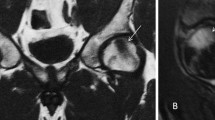Abstract
Introduction
The aim of the present study was to determine the incidence and type of complications during and after hip arthroscopy as well as the effect of the surgeon’s learning curve on the occurrence of complications. We expect that the currently reported prevalence especially of minor complications is likely to be underreported in most retrospective series based on chart analysis.
Materials and methods
The study included all consecutive patients who underwent hip arthroscopy between 2006 and 2014 at a minimum follow-up of 6 weeks starting with the first patient undergoing hip arthroscopy at the institution. Patient outcome was evaluated using the WOMAC score, VAS for pain, SF-36 questionnaire and the hip-outcome score. Additionally, intra- and postoperative complications were recorded via a questionnaire and additional review of patient files.
Results
We identified 529 patients who underwent hip arthroscopy between 2006 and 2014. Complete data could be gathered from 485 patients (91.7%). Major complications occurred in three patients (0.6%; fractures of the femoral neck requiring surgical treatment in one case). Minor complications that did not require further intervention were self-limiting postoperative temporary neurapraxia, hematoma, self-limiting dyspareunia, deep vein thrombosis and impaired wound healing, with hematoma and temporary paresthesia due to traction neurapraxia being the most common ones (22.5 and 16.4% respectively). The overall re-operation rate was 15.7% with conversion to total hip arthroplasty being the most common (11.9%).
Conclusions
The overall major complication rate was low and thus hip arthroscopy can be rated as a safe procedure. But minor complications such as hematoma and temporary paresthesia due to traction neurapraxia are common and currently underreported. Surgeons’ learning curves show a reduction of major complications once 60 procedures per surgeon per year is surpassed.



Similar content being viewed by others
References
Alradwan H, Philippon MJ, Farrokhyar F, Chu R, Whelan D, Bhandari M, Ayeni OR (2012) Return to preinjury activity levels after surgical management of femoroacetabular impingement in athletes. Arthroscopy 28(10):1567–1576
Botser IB, Smith TW Jr, Nasser R, Domb BG (2011) Open surgical dislocation versus arthroscopy for femoroacetabular impingement: a comparison of clinical outcomes. Arthroscopy 27(2):270–278
Hufeland M, Kruger D, Haas NP, Perka C, Schroder JH (2016) Arthroscopic treatment of femoroacetabular impingement shows persistent clinical improvement in the mid-term. Arch Orthop Trauma Surg 136(5):687–691
Konan S, Rhee SJ, Haddad FS (2011) Hip arthroscopy: analysis of a single surgeon’s learning experience. J Bone Joint Surg Am 93(Suppl 2):52–56
McCarthy JC, Lee JA (2006) Hip arthroscopy: indications, outcomes, and complications. Instr Course Lect 55:301–308
Ng VY, Arora N, Best TM, Pan X, Ellis TJ (2010) Efficacy of surgery for femoroacetabular impingement: a systematic review. Am J Sports Med 38(11):2337–2345
Clarke MT, Arora A, Villar RN (2003) Hip arthroscopy: complications in 1054 cases. Clin Orthop Relat Res 406:84–88. https://doi.org/10.1097/01.blo.0000043048.84315.af
Byrd JW (1994) Hip arthroscopy utilizing the supine position. Arthroscopy 10(3):275–280
Harris JD, McCormick FM, Abrams GD, Gupta AK, Ellis TJ, Bach BR Jr, Bush-Joseph CA, Nho SJ (2013) Complications and reoperations during and after hip arthroscopy: a systematic review of 92 studies and more than 6,000 patients. Arthroscopy 29(3):589–595
Kowalczuk M, Bhandari M, Farrokhyar F, Wong I, Chahal M, Neely S, Gandhi R, Ayeni OR (2013) Complications following hip arthroscopy: a systematic review and meta-analysis. Knee Surg Sports Traumatol Arthrosc 21(7):1669–1675
Fowler J, Owens BD (2010) Abdominal compartment syndrome after hip arthroscopy. Arthroscopy 26(1):128–130
Mardones RM, Gonzalez C, Chen Q, Zobitz M, Kaufman KR, Trousdale RT (2005) Surgical treatment of femoroacetabular impingement: evaluation of the effect of the size of the resection. J Bone Joint Surg Am 87(2):273–279
Ayeni OR, Bedi A, Lorich DG, Kelly BT (2011) Femoral neck fracture after arthroscopic management of femoroacetabular impingement: a case report. J Bone Joint Surg Am 93(9):e47
Jayasekera N, Aprato A, Villar RN (2013) Are crutches required after hip arthroscopy? A case-control study. Hip Int 23(3):269–273
Fukushima K, Takahira N, Uchiyama K, Moriya M, Minato T, Takaso M (2016) The incidence of deep vein thrombosis (DVT) during hip arthroscopic surgery. Arch Orthop Trauma Surg 136(10):1431–1435
Rhee SM, Kang SY, Jang EC, Kim JY, Ha YC (2016) Clinical outcomes after arthroscopic acetabular labral repair using knot-tying or knotless suture technique. Arch Orthop Trauma Surg 136(10):1411–1416
Ellenrieder M, Tischer T, Bader R, Kreuz PC, Mittelmeier W (2017) Patient-specific factors influencing the traction forces in hip arthroscopy. Arch Orthop Trauma Surg 137(1):81–87
Beckmann JT, Wylie JD, Potter MQ, Maak TG, Greene TH, Aoki SK (2015) Effect of naproxen prophylaxis on heterotopic ossification following hip arthroscopy: a double-blind randomized placebo-controlled trial. J Bone Joint Surg Am 97(24):2032–2037
Larson CM, Giveans MR (2008) Arthroscopic management of femoroacetabular impingement: early outcomes measures. Arthroscopy 24(5):540–546
Randelli F, Pierannunzii L, Banci L, Ragone V, Aliprandi A, Buly R (2010) Heterotopic ossifications after arthroscopic management of femoroacetabular impingement: the role of NSAID prophylaxis. J Orthop Traumatol 11(4):245–250
Bedi A, Zbeda RM, Bueno VF, Downie B, Dolan M, Kelly BT (2012) The incidence of heterotopic ossification after hip arthroscopy. Am J Sports Med 40(4):854–863
Griffin DW, Kinnard MJ, Formby PM, McCabe MP, Anderson TD (2016) Outcomes of hip arthroscopy in the older adult: a systematic review of the literature. Am J Sports Med. https://doi.org/10.1177/0363546516667915
Dietrich F, Ries C, Eiermann C, Miehlke W, Sobau C (2014) Complications in hip arthroscopy: necessity of supervision during the learning curve. Knee Surg Sports Traumatol Arthrosc 22(4):953–958
Lee YK, Ha YC, Hwang DS, Koo KH (2013) Learning curve of basic hip arthroscopy technique: CUSUM analysis. Knee Surg Sports Traumatol Arthrosc 21(8):1940–1944
Author information
Authors and Affiliations
Corresponding author
Ethics declarations
Conflict of interest
On behalf of all authors, the corresponding author states that there is no conflict of interest.
Rights and permissions
About this article
Cite this article
Schüttler, K.F., Schramm, R., El-Zayat, B.F. et al. The effect of surgeon’s learning curve: complications and outcome after hip arthroscopy. Arch Orthop Trauma Surg 138, 1415–1421 (2018). https://doi.org/10.1007/s00402-018-2960-7
Received:
Published:
Issue Date:
DOI: https://doi.org/10.1007/s00402-018-2960-7



